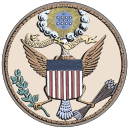
 |
|
Union states in the American Civil War |
|---|
|
|
| Dual governments |
| Territories and D.C. |
The East Tennessee Convention was an assembly of Southern Unionist delegates primarily from East Tennessee that met on three occasions during the Civil War. The convention most notably declared the secessionist actions taken by the Tennessee state government on the eve of the war unconstitutional, and requested that East Tennessee, where Union support remained strong, be allowed to form a separate state that would remain part of the United States split from the rest of Confederate Tennessee (a la West Virginia). The state legislature denied this request, and the Confederate Army occupied the region in late 1861.[1]
The convention first met in Knoxville on May 30–31, 1861, in response to the state government's "Declaration of Independence" from the United States and formation of a military league with the Confederacy. Congressman T. A. R. Nelson was elected president of the convention, and resolutions were adopted denouncing the state government's actions.[2] The convention met for the second time in Greeneville from June 17 to June 20, 1861, after Tennessee had voted to secede from the Union. This second meeting produced a memorial to the state government requesting East Tennessee be allowed to separate from Tennessee. The convention met for a final time in Knoxville from April 12 to April 16, 1864, to address the Emancipation Proclamation and the ten percent plan. This final meeting was marked by bitter divisions over the issue of slavery.[3][4]
Although it failed in its goal of establishing a Union-aligned state in East Tennessee, the convention played an important role in solidifying leadership and unity of purpose for the region's Unionists. Many of its delegates would serve in federal, state and local offices during the postwar period.[3]
- ^ Eric Lacy, Vanquished Volunteers: East Tennessee Sectionalism from Statehood to Secession (Johnson City, Tenn.: East Tennessee State University Press, 1965), pp. 122-126, 217-233.
- ^ Proceedings of the East Tennessee Convention (H. Barry Book Company, 1861). Accessed at the Calvin M. McClung Digital Collection, 14 December 2014.
- ^ a b Charles F. Bryan, Jr., "A Gathering of Tories: The East Tennessee Conventions of 1861," Tennessee Historical Quarterly, Vol. 39, No. 1 (Spring 1980), pp. 27-48.
- ^ Oliver Perry Temple, "The Knoxville-Greeneville Convention of 1861," East Tennessee and the Civil War (R. Clarke Company, 1899), pp. 340-365.
